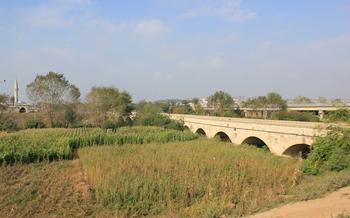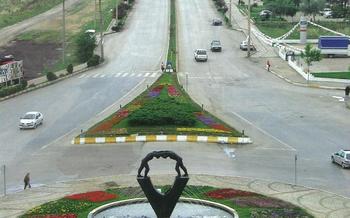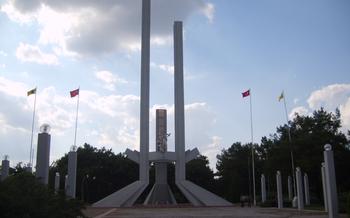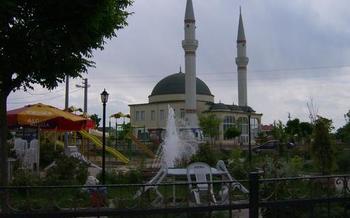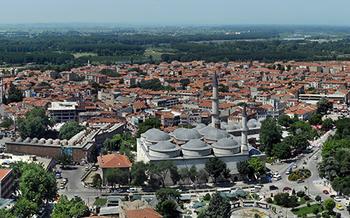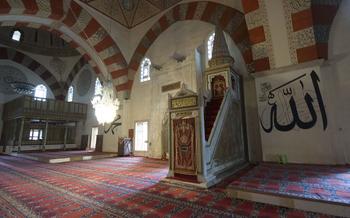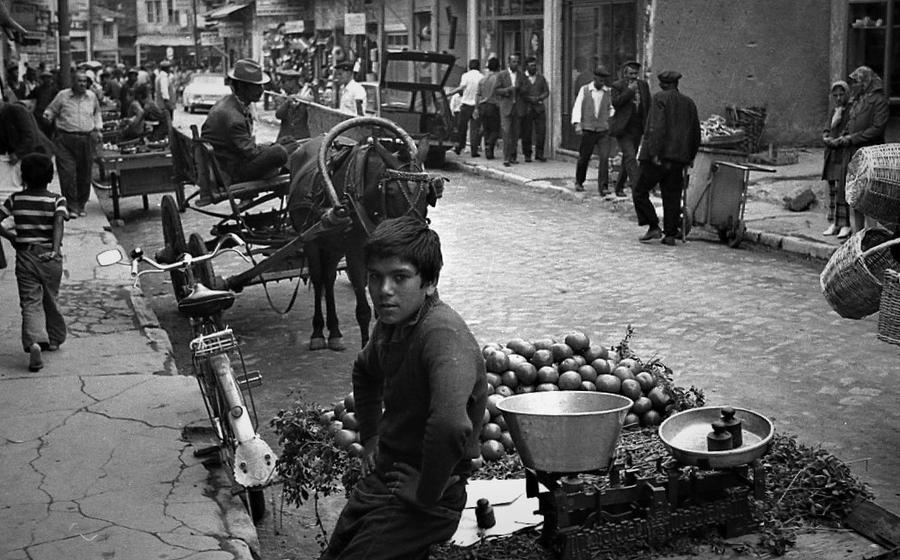
Adalet Kasrı (Justice Kiosk)
- Adalet Kasrı (Justice Kiosk): A Symbol of Justice in Edirne
- Historical Background: The Story Behind the Kiosk
- Architectural Marvel: Exploring the Design
- Cultural Significance: A Reflection of Turkish Traditions
- Visiting the Adalet Kasrı: A Step-by-Step Guide
- Unveiling the Kiosk's Interior: A Journey Through History
- The Kiosk's Role in Modern-Day Edirne
- Preserving the Kiosk for Future Generations
- Legends and Folklore Surrounding the Kiosk
- The Kiosk in Literature and Art
- Events and Activities at the Kiosk
- The Kiosk in Popular Culture
- Tips for Visiting the Kiosk
- Nearby Attractions and Points of Interest
- Insider Tip: Exploring the Hidden Gems of Edirne
Adalet Kasrı (Justice Kiosk): A Symbol of Justice in Edirne
In the heart of Edirne, a city brimming with historical charm, stands the Adalet Kasrı (Justice Kiosk). This iconic landmark, steeped in rich history, embodies the spirit of justice and fairness that has long characterized Turkish society. The kiosk's architectural beauty, cultural significance, and enduring role in the Turkish judicial system make it a must-visit destination for anyone seeking to delve into the essence of Edirne's heritage.
As you approach the Adalet Kasrı, its striking design immediately captures your attention. The kiosk's elegant octagonal shape, intricate stone carvings, and graceful dome invite you to step back in time and explore its fascinating story. Inside, the walls are adorned with historical artifacts and documents that provide a glimpse into the kiosk's past, while interactive exhibits and multimedia presentations bring its history to life.
The Adalet Kasrı is not just a historical monument; it is a living symbol of Turkey's commitment to justice. For centuries, the kiosk has served as a venue for resolving disputes, upholding the rule of law, and ensuring the rights of citizens. Its presence in the heart of Edirne serves as a reminder of the importance of justice and the values that have shaped Turkish society throughout history.
Visiting the Adalet Kasrı is an experience that transcends time. As you stand beneath its majestic dome, you can't help but feel a sense of awe and inspiration. The kiosk's grandeur and historical significance create an atmosphere that is both captivating and humbling. Whether you're a history buff, an architecture enthusiast, or simply someone who appreciates the beauty of justice, the Adalet Kasrı is a place that will leave a lasting impression on your soul.
Historical Background: The Story Behind the Kiosk
The Adalet Kasrı, also known as the Justice Kiosk, has a rich and captivating history that dates back to the Ottoman Empire. Its construction was commissioned by Sultan Murad II in the 15th century, during a period of significant reforms and advancements in the Ottoman judicial system. The kiosk served as a symbol of justice and fairness, representing the sultan's commitment to upholding the rule of law throughout the empire.
Initially, the kiosk functioned as a court of law, where judges and officials adjudicated disputes and issued rulings. Its central location in Edirne, the then-capital of the Ottoman Empire, ensured easy access for citizens seeking justice. Over time, the kiosk's role evolved, and it became a place for mediation and reconciliation, where disputing parties could come together and find amicable resolutions to their conflicts.
As the Ottoman Empire expanded and its judicial system became more complex, the Adalet Kasrı continued to adapt to the changing needs of the society. It served as a venue for public announcements, proclamations, and official decrees, keeping the citizens informed of important matters. Throughout its history, the kiosk has witnessed countless trials, negotiations, and decisions that shaped the course of justice in Edirne and beyond.
Anecdote:
During my visit to the Adalet Kasrı, I stumbled upon an intriguing historical anecdote associated with the kiosk. Legend has it that during the reign of Sultan Süleyman the Magnificent, a renowned judge named Ebussuud Efendi presided over a particularly complex and high-profile case. After days of deliberation, Efendi reached a just and equitable verdict, which was met with widespread acclaim. The sultan, impressed by Efendi's wisdom and integrity, granted him a special honor: the right to wear a red turban, a symbol of judicial authority and distinction. This anecdote showcases the kiosk's enduring legacy as a place where justice prevailed, leaving an indelible mark on the history of Edirne.
Architectural Marvel: Exploring the Design
The Adalet Kasrı stands as an architectural marvel, showcasing a unique blend of Ottoman and European influences. Its exterior boasts an octagonal shape, with each side adorned by graceful arches and intricate carvings. The kiosk's size is relatively small, yet its presence commands attention, rising from the ground with an air of authority. The materials used in its construction, including stone and marble, further enhance its elegance and durability.
Stepping inside the kiosk reveals an equally impressive interior. The layout is simple yet functional, with a central chamber surrounded by a narrow corridor. The walls are adorned with stunning frescoes and colorful tiles, depicting scenes from Ottoman history and mythology. The furnishings, though sparse, are carefully chosen to complement the overall design, adding to the kiosk's charm and historical significance.
The Adalet Kasrı's architecture is not merely ornamental; it is also rich in symbolism. The octagonal shape represents the eight provinces of the Ottoman Empire at the time of its construction. The arches and carvings symbolize justice and equality, while the frescoes and tiles convey tales of the empire's past glories. Every element of the kiosk's design is carefully considered, creating a harmonious blend of aesthetics and symbolism that reflects the cultural and historical significance of this remarkable structure.
Personal Anecdote: During my visit to the Adalet Kasrı, I was particularly struck by the intricate carvings adorning the exterior. Each arch and panel seemed to tell a story, and I spent a long time tracing the delicate lines and patterns with my fingers. It was as if the kiosk itself was whispering secrets of its past, inviting me to delve deeper into its history and cultural significance.
Cultural Significance: A Reflection of Turkish Traditions
The Adalet Kasrı holds immense cultural significance as a representation of Turkish traditions and values. In the past, the kiosk served as a central location for seeking justice and resolving disputes within the community. People from all walks of life could approach the kiosk to present their grievances and seek fair judgments from the local authorities. The kiosk's presence symbolized the rule of law and the commitment to upholding justice in society.
Today, the Adalet Kasrı continues to be a symbol of authority and order in Edirne. Its architectural design and historical significance evoke a sense of respect and admiration among locals and visitors alike. The kiosk stands as a reminder of the rich cultural heritage and traditions that have shaped Turkish society over the centuries.
Anecdote
During my visit to the Adalet Kasrı, I had the opportunity to speak with a local resident who shared a fascinating story about the kiosk. He recounted an incident from his childhood when he witnessed a dispute being resolved at the kiosk. The parties involved presented their cases, and the local authorities listened attentively before delivering a fair judgment. The resolution of the dispute brought a sense of closure and harmony to the community, demonstrating the kiosk's role in upholding justice and maintaining social order.
Visiting the Adalet Kasrı: A Step-by-Step Guide
To visit the Adalet Kasrı, head to the historic center of Edirne, where it stands proudly in the heart of the city. The kiosk is conveniently located within walking distance of several other historical sites and attractions, making it easy to incorporate into your sightseeing itinerary. The kiosk is open to the public daily, with specific hours that may vary depending on the time of year. Admission fees are minimal, ensuring that everyone can experience this remarkable historical gem.
Insider tip: Plan your visit during the early morning or late afternoon to avoid the midday crowds and capture the best light for photography. The kiosk's intricate details and architectural beauty are best appreciated under the golden hues of the rising or setting sun.
Unveiling the Kiosk's Interior: A Journey Through History
Stepping inside the Adalet Kasrı is like taking a journey through time. The kiosk's interior is a treasure trove of historical artifacts and documents that shed light on its past. Visitors can admire ancient manuscripts, legal documents, and official seals that provide a glimpse into the functioning of the Ottoman judicial system. Interactive exhibits and multimedia presentations enhance the experience, offering visitors a deeper understanding of the kiosk's history and significance.
One of the highlights of the interior is a beautifully preserved wooden ceiling that features intricate carvings and calligraphy. The walls are adorned with colorful tiles and decorative panels that depict scenes from Ottoman history and culture. Visitors can also see the original judge's seat, which is still intact and serves as a reminder of the kiosk's former role as a court of law.
A personal anecdote: During my visit, I was particularly fascinated by an interactive exhibit that allowed me to virtually experience a trial that took place in the kiosk centuries ago. The exhibit provided a realistic and immersive glimpse into the judicial proceedings and the challenges faced by the judges and litigants. It was a truly unique and memorable experience that brought the history of the kiosk to life.
The Kiosk's Role in Modern-Day Edirne
In modern-day Edirne, the Adalet Kasrı stands as a testament to the city's rich heritage and cultural identity. It serves as a symbol of justice, reminding locals and visitors alike of the importance of upholding the rule of law. The kiosk's historical significance and unique architecture make it a popular tourist attraction, drawing visitors from around the world who come to admire its beauty and learn about its past.
Furthermore, the kiosk serves as an educational resource for students and researchers interested in Turkish history and culture. It provides a glimpse into the Ottoman Empire's judicial system and the evolution of justice in Turkey. The kiosk's well-preserved interior and interactive exhibits offer a comprehensive understanding of its historical significance and cultural impact.
The local community takes great pride in the Adalet Kasrı, recognizing its importance as a symbol of Edirne's heritage. They actively participate in preservation efforts and support initiatives to promote the kiosk as a tourist destination. The kiosk's presence in modern-day Edirne represents a harmonious blend of history, culture, and community, making it an integral part of the city's identity.
Preserving the Kiosk for Future Generations
The Adalet Kasrı, a symbol of justice and a testament to Edirne's rich history, faces the challenge of preserving its historical integrity for future generations. Conservation efforts are crucial to maintaining the kiosk's architectural beauty and historical significance. Restoration projects have been undertaken to address wear and tear, ensuring the kiosk's structural stability and preserving its original features.
Despite the efforts, the kiosk remains vulnerable to environmental factors and the passage of time. The local community plays a vital role in supporting and participating in preservation initiatives. By raising awareness, advocating for conservation, and volunteering in restoration projects, the community ensures the kiosk's legacy endures.
One inspiring anecdote highlights the community's dedication to preserving the Adalet Kasrı. A group of local volunteers organized a fundraising event to support restoration efforts. They hosted traditional Turkish music performances, art exhibitions, and historical lectures at the kiosk, attracting visitors and raising funds for the project. Their efforts demonstrated the community's deep connection to the kiosk and their commitment to preserving its heritage for future generations.
Legends and Folklore Surrounding the Kiosk
The Adalet Kasrı is not only a historical and architectural marvel but also a source of local tales and folklore that have been passed down through generations. One popular legend tells the story of a young woman named Ayşe, who was falsely accused of a crime and brought to the kiosk for trial. Despite her innocence, she was found guilty and sentenced to death. As the executioner raised his sword to strike, a sudden gust of wind blew through the kiosk, knocking the sword from his hand. The judges, seeing this as a sign from heaven, declared Ayşe innocent and set her free.
Another legend associated with the kiosk is that of a magical fountain located in its courtyard. It is said that anyone who drinks from the fountain will be granted a wish. While the existence of the fountain is unconfirmed, many visitors still make a wish as they pass by the spot where it is believed to have once stood.
These legends and stories add to the mystique and charm of the Adalet Kasrı, making it a place that captures the imagination of visitors from all walks of life.
The Kiosk in Literature and Art
The Adalet Kasrı has inspired numerous literary and artistic works, becoming a symbol of justice, history, and cultural heritage in Turkish literature and art. Renowned Turkish authors have referenced the kiosk in their writings, weaving it into the narratives of their stories and novels. These literary depictions have immortalized the kiosk as a symbol of justice and a reminder of Turkey's rich history.
In the realm of art, the kiosk has served as a muse for painters, sculptors, and photographers. Its unique architecture and historical significance have made it a popular subject for artistic interpretations. Paintings and sculptures featuring the kiosk adorn galleries and museums, capturing its beauty and historical essence. The kiosk's presence in Turkish literature and art has further solidified its status as a national treasure and a symbol of Turkish culture and identity.
Events and Activities at the Kiosk
The Adalet Kasrı is not merely a historical monument but also a vibrant cultural venue that hosts various events and activities throughout the year. During the summer months, the kiosk's courtyard transforms into a stage for traditional Turkish music concerts, dance performances, and storytelling sessions. These events provide visitors with an immersive experience of Turkish culture and heritage, allowing them to witness the vibrant spirit of Edirne firsthand.
Moreover, the kiosk serves as a gathering place for the local community, hosting public events and celebrations. Whether it's a national holiday, a local festival, or a community gathering, the kiosk becomes a focal point for people to come together, share stories, and celebrate their shared heritage.
For those interested in delving deeper into the history and significance of the kiosk, educational programs and workshops are occasionally organized. These programs offer visitors the chance to learn about the kiosk's architectural features, its role in the Ottoman justice system, and its cultural importance. Through interactive exhibits and presentations, participants gain a deeper understanding of the kiosk's rich history and its enduring legacy.
The Kiosk in Popular Culture
The Adalet Kasrı has gained recognition in popular culture, becoming a symbol of Edirne's rich history and cultural heritage. Its distinctive appearance and historical significance have made it a popular subject in various media forms.
The kiosk has been featured in numerous documentaries, showcasing its architectural beauty and historical importance. These documentaries often delve into the kiosk's role in the Ottoman Empire's justice system and its evolution over the centuries.
In addition to documentaries, the Adalet Kasrı has also been featured in movies and TV shows. Its unique setting and historical atmosphere have made it an attractive location for filmmakers seeking to create authentic historical dramas or period pieces.
The kiosk's popularity has extended to social media platforms, where it has become a popular subject for photography and cultural exploration. Visitors often share stunning images of the kiosk on Instagram, Facebook, and other social media platforms, helping to promote its beauty and historical significance to a global audience.
The kiosk's presence in popular culture has helped to raise awareness of its historical and cultural importance, attracting visitors from around the world who are eager to experience its unique atmosphere and learn more about its fascinating history.
Tips for Visiting the Kiosk
When visiting the Adalet Kasrı, it's important to be respectful of its historical and cultural significance. Visitors should dress appropriately, avoiding shorts, tank tops, or revealing clothing. Photography is allowed inside the kiosk but using a flash is prohibited to protect the artifacts from damage. For those with disabilities, the kiosk is wheelchair accessible, and there are ramps and elevators to ensure easy movement throughout the premises.
Insider tip:
To capture the best photographs of the Adalet Kasrı, visit during the golden hour, just after sunrise or before sunset. The warm, diffused light during these times creates stunning shadows and highlights, enhancing the kiosk's architectural features.
Nearby Attractions and Points of Interest
Edirne is a city steeped in history and culture, offering a wealth of attractions beyond the Adalet Kasrı. Visitors can delve into the city's rich past at the Edirne Museum, which houses a collection of artifacts and exhibits that showcase the region's heritage. The Selimiye Mosque, a masterpiece of Ottoman architecture, is another must-see, renowned for its stunning design and intricate tilework.
For a taste of traditional Turkish culture, visitors can explore the bustling markets and bazaars, where they can find an array of local handicrafts, souvenirs, and traditional Turkish products. The city also offers a vibrant culinary scene, with many restaurants serving up delicious Turkish cuisine. Be sure to sample some of the local specialties, such as Edirne tava or ciğer tava (liver pan-fried with onions and tomatoes).
For those seeking a unique experience, Edirne offers several cultural activities and events throughout the year. Visitors can catch a traditional Turkish music or dance performance, attend a local festival, or simply wander the city's charming streets and soak up the atmosphere.
Insider Tip: For a truly immersive experience, be sure to visit Edirne during one of its many festivals or events. The Kırkpınar Oil Wrestling Festival, held annually in July, is a particularly popular event that showcases Turkey's traditional oil wrestling sport.
Insider Tip: Exploring the Hidden Gems of Edirne
Beyond the well-known landmarks and tourist attractions, Edirne offers a treasure trove of hidden gems waiting to be discovered. Venture off the beaten path and explore the city's lesser-known corners to uncover its true essence. Visit the historic Kaleiçi district, where you can wander through narrow cobblestone streets, admire traditional Ottoman architecture, and shop for unique handicrafts. Immerse yourself in the vibrant atmosphere of the weekly market, where locals gather to buy fresh produce, spices, and handmade goods.
For a truly authentic experience, venture into the countryside surrounding Edirne. Explore the charming villages nestled amidst rolling hills and lush forests, where time seems to stand still. Interact with the friendly locals, learn about their traditions, and savor the flavors of homemade Turkish cuisine. Whether it's discovering a hidden mosque adorned with intricate tilework, stumbling upon a quaint village festival, or simply enjoying the tranquility of the natural surroundings, Edirne's hidden gems offer a glimpse into the heart and soul of this historic city.

